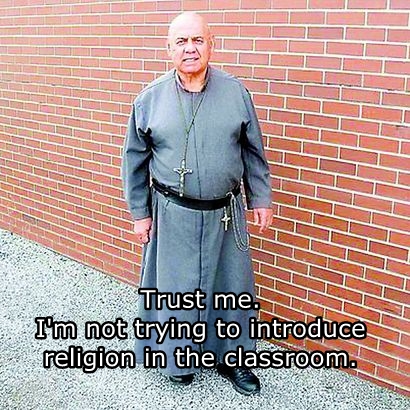Article by Colonel Nogov on Aug. 28, 2015
Roman Catholic Priest George Nedeff is a recent hire in Wood County West Virginia as a substitute teacher. After being hired, he is now petitioning the Wood County Board of Education to be allowed to wear his religious symbols while teaching students.
Those symbols include his gray priestly robes, a crucifix and a rosary. See photo.
Nedeff was a substitute teacher in the district many years ago before relocating to Texas to practice his faith. It is unclear whether or not the school district knew Nedeff was a priest prior to his rehire although he has been a priest for nine years.
“I am a priest. I am proud of it,” Nedeff said. “I’m proud of the religious order I’m part of, and this is my life now.”
Nedeff expressed his feelings of how he believed having a religious man of faith would somehow benefit the students. “I think the students would have a sense of reassurance by having a religious priest substituting in their schools.” He said. Countless adolescents molested at the hand of Catholic Priests would likely disagree with that assessment.
No decision has been made by the Wood County Board of Education. That didn’t stop Nedeff from making the claim, “I received permission”.
Superintendent John Flint said, “We respect and appreciate Father Nedeff’s request, but there has been no decision made at this time”.
A spokeswoman for the West Virginia Department of Education, Kirsten Anderson – executive director of communications – said there is no state code regarding the matter. Upon looking for federal guidance she stated, “Title VII of the Civil Rights Act of 1964 requires employers, including schools, to reasonably accommodate the religious practices of an employee, unless doing so would create an undue hardship on the employer, yet public schools must also comply with the U.S. Constitution’s Establishment Clause, which prevents employees from advocating a particular belief system in front of students.”
Anderson didn’t elaborate on whether or not she thought it was a reasonable accommodation for a priest to advocate and display symbols of a particular religious belief in the classroom in direct violation of the U.S. constitution’s establishment clause.
